Life, Customs and Diet of the Capybara in Peru
Introduction to the Capybara:
The capybara (Hydrochoerus hydrochaeris) is the largest rodent in the world and a fascinating inhabitant of the humid regions of South America, including Peru. This social and adaptable animal offers a unique insight into the Amazonian ecosystem and is one of the most intriguing species you can find in the Manu Reserve and other similar areas.
In the Manu Reserve and other regions of Peru, the animal known as the capybara (Hydrochoerus hydrochaeris) is recognized by several local names, depending on the language and region. In general, the most common names include:
- Capibara: This is the most widely used name, derived from the Guaraní term “kapybara,” meaning “lord of the pastures.” It is the common name in Spanish and is used throughout much of Peru.
- Carpincho: Another common name in Spanish, especially in some areas of South America. The term “capybara” is also used in other parts of the continent, such as Argentina and Uruguay.
In the Manu Reserve and the Peruvian Amazon, you can also find local references that vary depending on the indigenous community. However, “capybara” and “carpincho” are the most universal and recognized terms in the region.
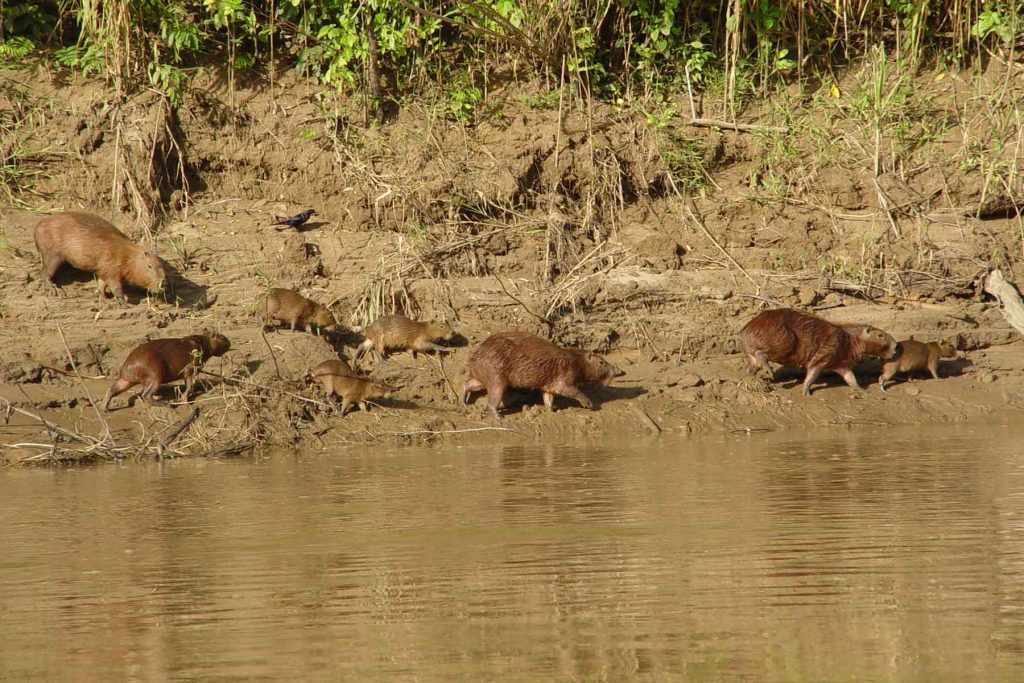
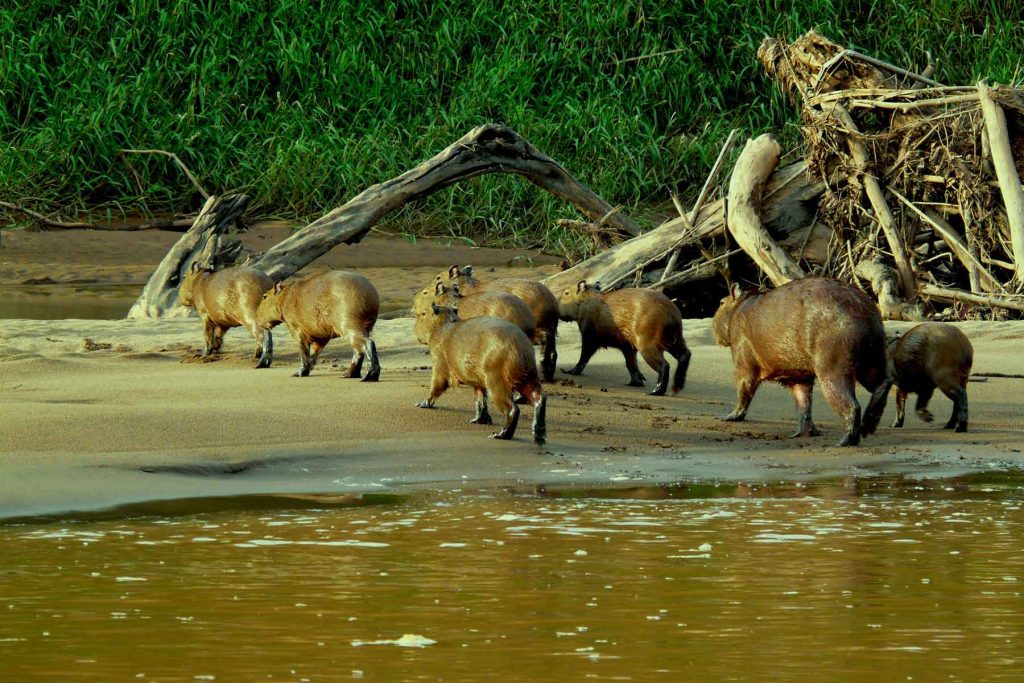
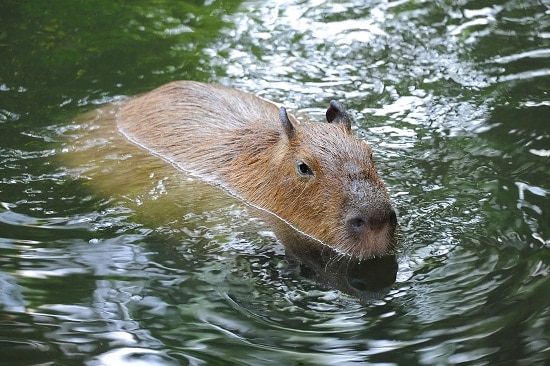
Capybara Habitat and Distribution:
In Peru, capybaras are found in various aquatic habitats, such as rivers, lakes, swamps, and wetland areas. The Manu Reserve, with its lush vegetation and abundant water, provides the ideal environment for these rodents. They prefer areas close to water, where they can cool off and find their main source of food.
Capybara Behavior and Customs:
- Social Life: Capybaras are extremely social animals that live in family groups or groups of up to 20 individuals. Within the group, specific hierarchies and roles are established, which contributes to their organized social structure. Cooperation and mutual care are fundamental to their well-being.
- Daytime Activity: Unlike many wild animals, capybaras are active primarily during the day. They can be seen grazing, socializing, or taking baths in water to regulate their temperature.
- Communication: Capybaras use a variety of sounds to communicate with each other, including squeaks, grunts, and whistles. These sounds help coordinate the group’s activities and alert others to potential danger.
Capybara Diet:
- Herbivorous Diet: Capybaras are strict herbivores. Their diet is composed primarily of grasses, leaves, bark, and fruits. In their natural habitat, they forage for aquatic plants and vegetation that grows near bodies of water.
- Feeding Habits: They are known for their grazing behavior, and can often be observed eating for several hours a day. Their digestive system is adapted to process large amounts of plant material. Capybaras also practice coprophagy, that is, they eat their own feces to extract additional nutrients.
- Dietary Adaptations: Their ability to consume a wide variety of vegetation allows them to adapt to different types of habitats and conditions. This helps them survive in the diverse and changing ecology of the Peruvian Amazon.
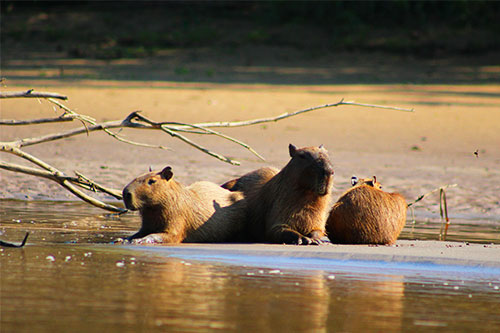
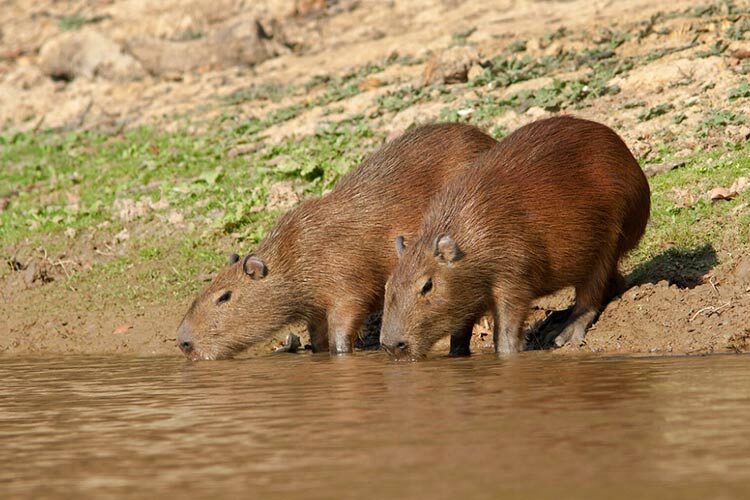
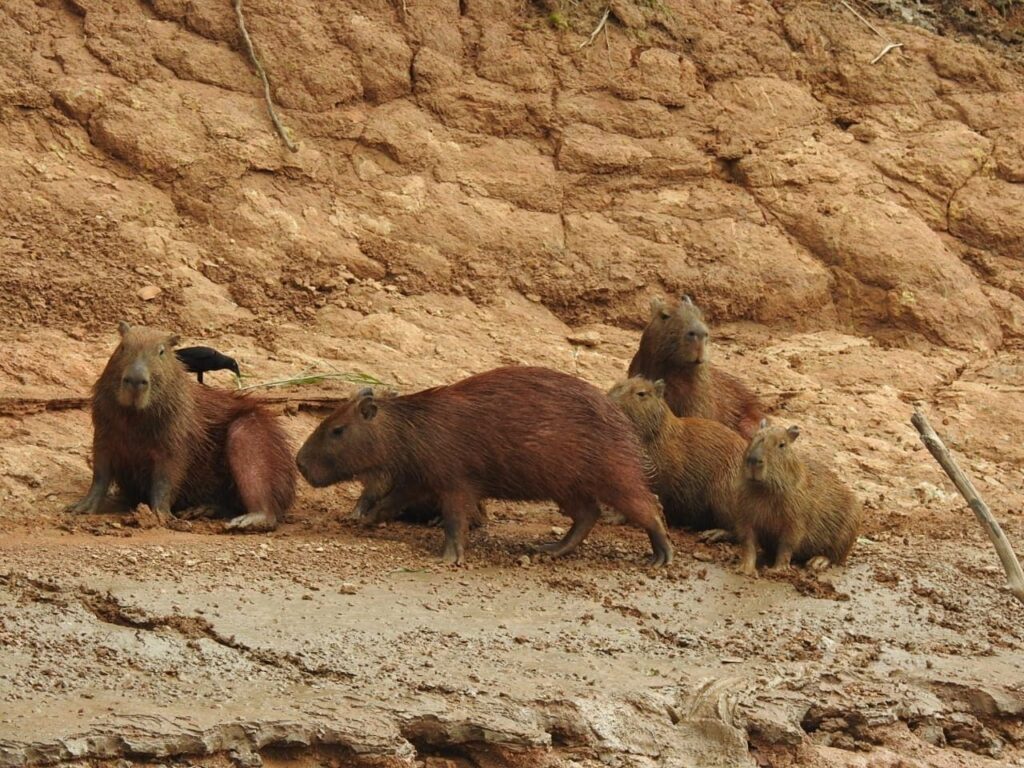
Tips for Capybara Watchers:
- Respect Space: Although capybaras are generally calm and curious, it is important to maintain a respectful distance. Don’t get too close so as not to disturb their natural behavior.
- Behavior Observation: For an enriching experience, observe how they interact within their group and how they feed. Capybaras are usually quite relaxed, allowing for detailed observation of their habits.
- Professional Local Guides from the Area: Hiring specialized local guides can enhance your experience, providing additional information and ensuring that your visit is safe for both you and the capybaras.
Exploring the life of the capybara in Peru is an opportunity to experience up close the social dynamics and unique behaviors of this fascinating rodent in the Peruvian Amazon. Enjoy your adventure and always remember to follow the guidelines of respect and conservation to protect these wonderful animals and their natural habitat of the capybara in the Manu Reserve and the Tambopata Reserve with the travel and tourism agency AMAZONPERUTRAVELLERS.COM consult for more information.
The capybara (Hydrochoerus hydrochaeris) in Peru is an emblematic species of the region’s aquatic ecosystems. Here are some additional details about its biology, behavior, and the role it plays in its natural environment:
Biological Characteristics of the Capybara:
- Size and Appearance: The capybara is the largest rodent in the world, with a size that can reach up to 1.3 meters long and 60 centimeters high at the shoulder. Its weight varies between 35 and 66 kilograms. They have a robust, cylindrical body with short legs and a large head, adapted for their herbivorous diet.
- Coat: Their coat is brown to grayish in color, with a rough, short coat that helps protect them from inclement weather and makes swimming easier. In addition, they have glands in their skin that secrete an oily substance that protects them from water.
Capybara Social Behavior:
- Group Structure: Capybara groups are formed by a complex social structure. Groups are usually composed of a dominant pair and their offspring, along with other adults and juveniles. Dominant males have priority in access to females and resources.
- Hierarchy: Within the group, there are social hierarchies that determine access to food and resting areas. Social interactions include behaviors such as mutual grooming, which strengthens bonds between group members.
Capybara Reproduction:
- Breeding Season: Capybara breeding usually occurs during the rainy season, when food resources are most abundant. Gestation lasts approximately 150 days, and the female usually gives birth to between 4 and 6 pups.
- Parental Care: The pups are born well developed and are able to follow the mother shortly after birth. The mother and other members of the group care for and protect the pups, and the young remain with the group until they reach sexual maturity.
Relationship with the Ecosystem of Capybaras:
- Ecological Role: Capybaras play a crucial role in their ecosystem by controlling aquatic vegetation and serving as prey for predators. Their diet affects the structure of vegetation in wetlands and contributes to the dynamics of aquatic ecosystems.
- Interaction with Other Animals: They are a food source for several predators, including jaguars, pumas, and caimans. Their presence also influences local biodiversity by affecting the structure of aquatic habitats.
Capybara Adaptations and Survival Strategies:
- Swimming and Diving: Capybaras are excellent swimmers and can stay underwater for several minutes. They use water not only to cool off and escape predators, but also to find food and socialize.
- Sheltering Behavior: During the day, capybaras often take shelter in shaded areas near water. This helps them regulate their body temperature and avoid sun exposure.
Capybara Conservation and Threats:
- Conservation Status: Although capybaras are classified as “Least Concern” on the IUCN Red List, they face threats in some areas due to habitat loss, hunting by traffickers, and competition with domestic livestock for resources.
- Conservation in Peru: In Peru, capybaras are protected in several reserves and national parks, such as the Manu Reserve. Protecting their natural habitat and sustainably managing conservation areas and protecting capybaras is crucial to their long-term well-being.
Tips for Capybara Watching:
- Best Watching Times: The best times to watch capybaras are at dawn and dusk, when they are most active. In the Manu Reserve, boat trips along the rivers and lakes offer good opportunities to see these animals in their natural environment.
- Visitor Responsibility: Always respect the rules of the parks and reserves, keep a safe distance and do not interfere with the natural behaviors of the animals. Responsible viewing helps ensure the conservation of these species and their habitat.
Exploring the life of the capybara in Peru offers a fascinating insight into how these animals interact with their environment and how they contribute to the biodiversity of the Amazon region. Their presence in the Amazon ecosystem is a testament to the rich wildlife and importance of conservation in these vital areas.

Comments are closed